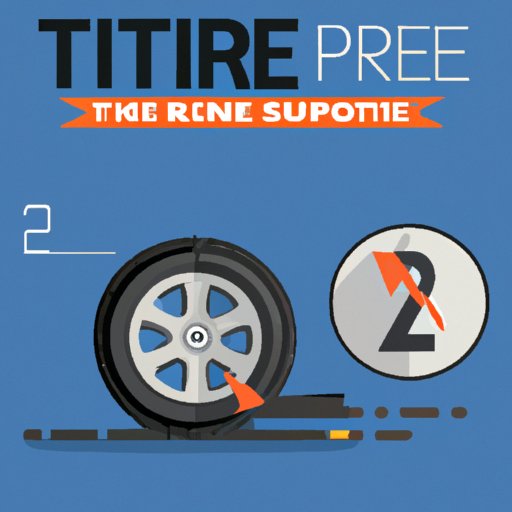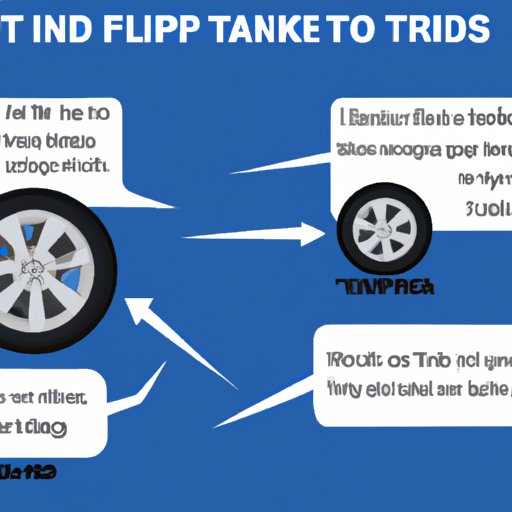
I. Introduction
Getting a flat tire while driving can be a terrifying experience, especially if it happens on a busy highway or in an unfamiliar area. Not only is it a safety hazard, but it can also cause lasting damage to your vehicle. In this article, we will explore the risks and dangers of driving with a flat tire, what to do if it happens to you, and how to prevent it from happening again in the future.
II. The Risks and Dangers of Driving with a Flat Tire: What You Need to Know
Driving with a flat tire can cause a number of problems and risks, including:
- Loss of control: A flat tire can make it difficult to steer or brake, causing you to lose control of your vehicle.
- Rim damage: Driving on a flat tire can cause damage to the rim, making it more difficult to fit a new tire and ultimately leading to additional expenses.
- Other vehicle damage: A flat tire can cause damage to the suspension system and other parts of the vehicle, leading to costly repairs.
It’s important to take a flat tire seriously and assess the situation before making any decisions. Continuing to drive on a flat tire can put your safety at risk and cause additional damage to your vehicle.
III. Steps to Take If You Get a Flat Tire While Driving
If you discover a flat tire while driving, take the following steps:
- Find a safe spot to pull over: Look for a clear and level spot to pull over, away from traffic and oncoming cars.
- Turn on hazard lights: Let other drivers know that you are stopped and that there might be an issue with your vehicle.
- Assess the tire: Determine if the tire is completely flat or only partially, and whether it’s safe to continue driving or if it needs to be replaced or repaired.
- Decide on a plan of action: Depending on your situation, you might be able to change the tire yourself or call for professional help. Consider your personal safety, ability to change the tire, and condition of your vehicle before making a decision.
IV. Why Driving with a Flat Tire can Cause Irreparable Damage to Your Vehicle
Driving with a flat tire can cause damage to your vehicle, including the wheel, suspension system, and other parts of the car. Continuing to drive on a flat tire can cause additional damage and be expensive to repair. It’s crucial to recognize the potential for long-term vehicle damage and make thoughtful decisions about how to address a flat tire.
V. When to Seek Professional Help vs. Attempting to Change a Flat Tire Yourself
Changing a flat tire yourself can be a difficult task, especially if you’re not familiar with your vehicle or lack the necessary equipment or tools. However, depending on the extent of the damage and your personal safety concerns, you might be able to change the tire yourself. Consider the following factors before attempting to change a flat tire:
- Safety: Ensure that you are parked in a safe location and that you are taking appropriate safety measures while changing the tire.
- Skill level: Determine whether you have the necessary knowledge and experience to change the tire yourself.
- Vehicle type: Some vehicles, such as larger trucks or sports cars, might require special equipment or tools to change the tire.
If you are unsure or uncomfortable changing the tire yourself, it’s best to call for professional help. Additionally, if there is severe damage to the tire or wheel, lack of equipment or tools, or personal safety concerns, it’s best to call for help rather than attempt to change the tire yourself.
VI. Legal Consequences of Driving with a Flat Tire: What You Need to Know
Driving with a flat tire can result in legal consequences, including traffic violations and liability in the event of an accident. It’s important to understand local laws and regulations regarding safe driving and vehicle maintenance to avoid legal issues.

VII. Tips and Tricks for Preventing Flat Tires While Driving
Preventative measures are the best way to avoid getting a flat tire while driving. Consider these tips and tricks:
- Regular tire maintenance: Check your tire pressure and tread regularly to ensure they are in good condition.
- Proper inflation levels: Ensure that your tires are inflated to the recommended level to avoid damage and prevent flats.
- Avoid hazards on the road: Stay alert and avoid potholes, debris, and other hazards on the road that can cause damage to your tires.
By taking proactive measures, you can minimize the risk of getting a flat tire while driving and keep your vehicle safe.
VIII. Conclusion
Getting a flat tire while driving is never a pleasant experience, and it can put your safety and your vehicle’s health at risk. By understanding the risks and dangers of driving with a flat tire, taking appropriate steps if it happens to you, and implementing preventative measures, you can avoid potential issues and keep yourself and your vehicle safe on the road.




